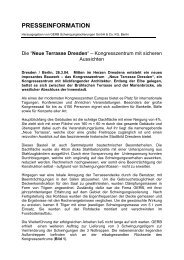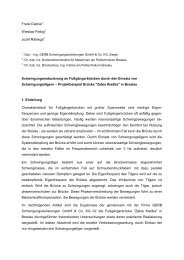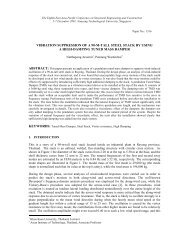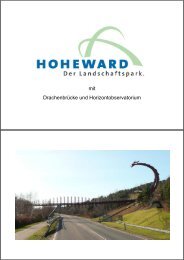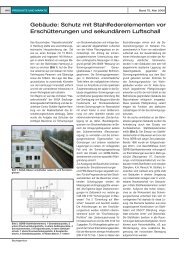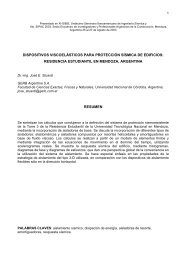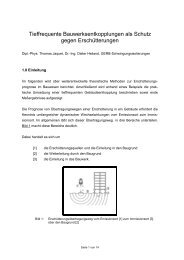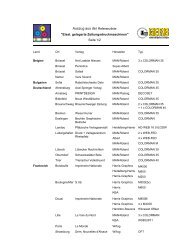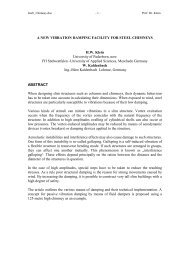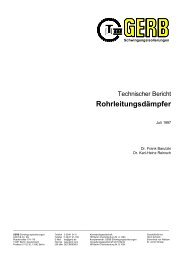ABSTRACT A vibration isolation system using spring units and visco ...
ABSTRACT A vibration isolation system using spring units and visco ...
ABSTRACT A vibration isolation system using spring units and visco ...
Create successful ePaper yourself
Turn your PDF publications into a flip-book with our unique Google optimized e-Paper software.
<strong>ABSTRACT</strong><br />
(Revised English Version)<br />
A <strong>vibration</strong> <strong>isolation</strong> <strong>system</strong> <strong>using</strong> <strong>spring</strong> <strong>units</strong> <strong>and</strong> <strong>visco</strong>-elastic dampers can reduce <strong>vibration</strong> <strong>and</strong><br />
structure borne noise in a building near subway or other traffic facilities effectively. For applying<br />
this <strong>system</strong> in Japan, it is necessary to confirm the seismic safety. So an experimental <strong>and</strong><br />
analytical study was done.<br />
At first static loading tests of the <strong>spring</strong> <strong>units</strong> <strong>and</strong> dynamic loading tests of a <strong>visco</strong>-elastic damper<br />
were carried out. Then analytical models for the <strong>spring</strong>s <strong>and</strong> <strong>visco</strong>-elastic dampers were<br />
developed. At the next stage shaking table tests with the model of a <strong>vibration</strong> isolated building<br />
were performed in order to examine the <strong>vibration</strong> characteristics <strong>and</strong> behaviours of the structure.<br />
Finally a four story <strong>vibration</strong> isolated building supported by such a <strong>system</strong> was designed with the<br />
confirmation of the seismic safety of the building by analysis based on the proposed model.<br />
KEYWORDS<br />
<strong>vibration</strong> <strong>isolation</strong> <strong>system</strong>, helical steel <strong>spring</strong>, <strong>visco</strong>-elastic damper, loading test, shaking table<br />
test, response analysis.<br />
1. INTRODUCTION<br />
Recently many buildings have been constructed near subways or other traffic facilities in inner city<br />
areas of Japan where <strong>vibration</strong> or structure borne noise reduces the quality of life of the people<br />
living here. To avoid this problem, it is useful to adopt <strong>vibration</strong> <strong>isolation</strong> <strong>system</strong>s <strong>using</strong> <strong>spring</strong> <strong>units</strong><br />
<strong>and</strong> <strong>visco</strong>-elastic dampers. For this purpose, an experimental <strong>and</strong> analytical study has been done<br />
including the design of a four story building with consideration of its seismic safety.
2. VIBRATION ISOLATION SYSTEM<br />
2.1 Details of the <strong>system</strong><br />
Helical steel <strong>spring</strong>s are used to support the weight of the building providing a low vertical natural<br />
frequency of the <strong>spring</strong> supported building, so that the higher frequency parts of the traffic<br />
<strong>vibration</strong>s can be isolated to a high degree. The <strong>visco</strong>-elastic dampers react in all three<br />
dimensions. They can, therefore, be placed near to the corners of the building.<br />
Both, <strong>spring</strong>s <strong>and</strong> dampers, are concentrated in several locations where the number of <strong>spring</strong> <strong>units</strong><br />
<strong>and</strong> dampers is controlled by the load distribution of the upper structure.<br />
The <strong>system</strong> has the following characteristics:<br />
1) With helical <strong>spring</strong> support of the building its natural frequencies, both in vertical <strong>and</strong> horizontal<br />
direction, can be set quite low, so that <strong>vibration</strong> <strong>and</strong> structure borne noise from subways or<br />
other traffic is highly reduced.<br />
2) Since <strong>visco</strong>-elastic dampers react three dimensionally, it is needless to arrange dampers for<br />
vertical <strong>and</strong> horizontal direction independently, <strong>and</strong> it is, therefore, easy to concentrate the<br />
devices in the corners.<br />
Fig. 1 Sectional plan of the building Fig. 2 Arrangement of devices in the building
2.2 Composition of the <strong>system</strong><br />
2.2.1 Helical steel <strong>spring</strong> elements<br />
Several helical steel <strong>spring</strong>s are used as a <strong>spring</strong> unit. Usually a <strong>spring</strong> unit, consisting of the<br />
<strong>spring</strong>s <strong>and</strong> a top <strong>and</strong> bottom plate, can resist only compression forces. But in this special <strong>system</strong>,<br />
<strong>spring</strong>s can resist compression <strong>and</strong> tension force because both ends of the <strong>spring</strong>s are fixed to the<br />
end plates (see Fig. 3).<br />
Fig. 3 Spring unit Fig. 4 Damper<br />
2.2.2 Visco-elastic dampers<br />
Visco-elastic dampers consist of three parts as shown in Fig. 4.<br />
(1) Lower cylindrical vessel<br />
(2) Visco-elastic liquid in the vessel<br />
(3) Cylindrical piston submerged in the <strong>visco</strong>-elastic liquid.<br />
The cylindrical piston can move in the <strong>visco</strong>-elastic liquid three-dimensionally relative to the<br />
movement of the lower vessel transferring <strong>vibration</strong> energy in this way into heat.<br />
3. DYNAMIC TEST OF THE DEVICES<br />
Several dynamic tests of the <strong>spring</strong> <strong>units</strong> <strong>and</strong> the <strong>visco</strong>-elastic dampers were done.<br />
3.1 Dynamic test of the characteristics of the <strong>spring</strong> unit<br />
3.1.1 Outline of the test<br />
The <strong>spring</strong> unit contains seven helical steel <strong>spring</strong>s fixed to the end plates. The natural frequency<br />
in the vertical direction of the <strong>spring</strong> supported <strong>system</strong> is 2.5 Hz.<br />
The test pattern is<br />
(1) Horizontal loading test at different displacements in vertical direction.<br />
(2) Vertical loading test at some displacements in horizontal direction.
3.1.2 Cyclic horizontal loading test<br />
(1) Loading<br />
At first the <strong>spring</strong> unit is deformed vertically by - 20 mm, - 10 mm (tension), 5 mm, 15 mm, 40 mm<br />
(compression). Then the unit is pushed in two horizontal directions in a right angle by a cyclic load<br />
of a hydraulic jack.<br />
(2) Displacements<br />
The horizontal displacement is ± 10 mm in the first cycle, ± 20 mm in the second cycle, ± 30 mm in<br />
the third cycle <strong>and</strong> ± 42 mm in the forth cycle.<br />
(3) Results<br />
Fig. 5 shows the relation between horizontal load <strong>and</strong> displacement.<br />
Fig. 6 shows the relation between horizontal <strong>spring</strong> rate <strong>and</strong> vertical displacement.<br />
According to Fig. 6, the horizontal <strong>spring</strong> rate increases with increasing vertical displacements. The<br />
results are the same in both horizontal directions.<br />
Fig. 5 Horizontal load-displacement line Fig. 6 Relation between horizontal <strong>spring</strong> rate<br />
<strong>and</strong> vertical displacement<br />
3.1.3 Cyclic vertical loading test<br />
(1) Loading<br />
At first the <strong>spring</strong> unit is deformed horizontally by 0 mm, 30 mm, 42 mm. Then the unit is<br />
dynamically loaded in vertical direction cyclically by a hydraulic jack.<br />
(2) Displacements<br />
At first the <strong>spring</strong> unit is compressed statically by 40 mm. Then it is vertically loaded by ± 20 mm in<br />
the first cycle, ± 30 mm in the second cycle, ± 40 mm in the third cycle <strong>and</strong> ± 50 mm in the fourth<br />
cycle.
(3) Results<br />
Fig. 7 shows the relation between vertical load <strong>and</strong> displacement.<br />
Fig. 8 shows the relation between vertical stiffness <strong>and</strong> horizontal displacement.<br />
According to Fig. 8 vertical stiffness increases at increasing horizontal displacements.<br />
Fig. 7 Vertical load displacement line Fig. 8 Vertical stiffness versus horizontal displacement<br />
3.2 Test of the characteristics of the <strong>visco</strong>-elastic damper<br />
3.2.1 Outline of the test<br />
The vertical <strong>and</strong> horizontal characteristics of the <strong>visco</strong>-elastic damper were found in a test with<br />
r<strong>and</strong>om noise excitation <strong>and</strong> tests with sinusoidal force excitation at several frequencies.<br />
3.2.2 Vibration test in vertical <strong>and</strong> horizontal direction<br />
(1) Vibration<br />
Vibrations were excited by r<strong>and</strong>om noise or sinusoidal loads. The frequency range of the r<strong>and</strong>om<br />
noise was 0 to 5 Hz <strong>and</strong> 3 to 50 Hz. The amplitude range was very small. The amplitude range of<br />
the vertical sinusoidal excitation was 5 ~ 45 mm at 1 Hz, 5 ~ 15 mm at 2 Hz <strong>and</strong> 2 ~ 12 mm at<br />
5 Hz. The amplitude range of the horizontal sinusoidal excitation was 5 ~ 30 mm at 1 Hz,<br />
5 ~ 15 mm at 1,5 Hz <strong>and</strong> 2 ~ 15 mm at 3 Hz.<br />
�� Results of r<strong>and</strong>om noise excitation<br />
Fig. 9 Displacement dependency<br />
of damping resistance
(2) Result<br />
According to the tests, the damping coefficient decreases <strong>and</strong> the stiffness increases with<br />
increasing frequency.<br />
Fig. 9 shows the displacement dependency of the damping coefficient. The horizontal damping<br />
coefficient decreased down to 87 % compared to that at r<strong>and</strong>om noise excitation when the<br />
amplitude was 30 mm. The vertical damping coefficient decreased down to 60 % compared to that<br />
at r<strong>and</strong>om noise excitation when the amplitude was 45 mm.<br />
4. SEISMIC RESPONSE ANALYSIS OF THE VIBRATION ISOLATED BUILDING<br />
4.1 Analysis model<br />
The analysis model is shown in Fig. 10<br />
(1) The upper parts of the building were assumed as concentrated masses connected by <strong>spring</strong>s.<br />
(2) The ground floor was assumed as a solid slab.<br />
(3) The <strong>spring</strong> elements <strong>and</strong> <strong>visco</strong>-elastic dampers were put under the columns of the ground floor.<br />
(4) The analysis model was designed as a three dimensional model.<br />
The data for the analysis are shown in Table 1.<br />
Fig. 10 Analysis model of the building<br />
4.1.1 Modelling of the <strong>spring</strong>s<br />
The <strong>spring</strong> coefficients of the <strong>spring</strong> depend on the deformation of the <strong>spring</strong>. The model of the<br />
<strong>spring</strong> (shown in Fig. 11) was, therefore, composed of a vertical <strong>spring</strong> <strong>and</strong> a multi <strong>spring</strong> element<br />
for the horizontal shear direction. Both elements were given restoration characteristics gained from<br />
the experiments. The response calculation was done step by step with the tangential stiffness at<br />
each step.
4.1.2 Modelling of the damper<br />
The damping coefficients have a displacement dependency according to the experiments. These<br />
dynamic characteristics of the damper are introduced into a four parameter model as shown in<br />
Fig 12,<br />
Fig. 11 Isolation <strong>spring</strong> element Fig. 12 4 parameter model Table 2 Parameters of the 4 parameter model<br />
where the damping coefficients <strong>and</strong> the damper stiffnesses are taken into account according to the<br />
experiments for every frequency. According to Fig. 9 the damping coefficients were reduced to<br />
87 % in the horizontal direction <strong>and</strong> to 60 % in the vertical direction. The parameters of the<br />
4 parameter model are shown in Table 2.<br />
4.2 The procedure of the response analysis<br />
With the help of a three dimensional frequency response analysis program <strong>and</strong> a three<br />
dimensional time history response analysis program the response analysis was done as follows.<br />
(1) The <strong>spring</strong> rates of the <strong>spring</strong> unit were assumed to be linear. In this way the three dimensional<br />
frequency response analysis program was run. Next, the three dimensional time history response<br />
analysis program was run. Then the similarity of the two wave forms gained from the two analysis<br />
was compared.<br />
(2) The <strong>spring</strong> was modeled as a combination of a vertical <strong>spring</strong> element <strong>and</strong> a multi <strong>spring</strong><br />
element for the horizontal shear direction. The damper was modeled as a four parameter model as<br />
shown in Fig. 12. Then the three dimensional frequency response analysis program was run.<br />
4.3 Earthquake records used<br />
Earthquake records used in this analysis were modified from those of El Centro, Taft <strong>and</strong><br />
Hachinohe Earthquakes. The strength levels of the earthquake records were 50 kine for the<br />
horizontal NS <strong>and</strong> EW direction vectors.
4.4 Results<br />
The acceleration time histories of X <strong>and</strong> Y directions for the roof floor resulting from the three<br />
dimensional frequency response analysis <strong>and</strong> the three dimensional time history response analysis<br />
based on the EW wave of El Centro in X direction are shown in Fig. 13. Both time histories are<br />
very similar in wave form <strong>and</strong> maximum acceleration.<br />
(a) Frequency response analysis (b) Time history response analysis<br />
Fig. 13 Acceleration response (RFX,Y-direction)<br />
(a) Frequency response analysis (b) Time history response analysis Table 3 Maximum response<br />
Fig. 14 Transfer function (RF X-direction)<br />
The transfer functions of the two response analyses are shown in Fig. 14. Both are very similar<br />
below 10 Hz, but above 10 Hz the response of the time history analysis is lower than that of the<br />
frequency response analysis.<br />
The detailed analysis results are shown in Table 3.
5. SHAKING TABLE TEST OF THE ISOLATED BUILDING MODEL<br />
5.1 Shaking table test<br />
5.1.1 Model<br />
The model was designed to have the same natural frequency <strong>and</strong> the same damping ratio as the<br />
real building. The <strong>isolation</strong> <strong>system</strong> was composed of six <strong>spring</strong>s <strong>and</strong> four dampers. The<br />
accelerations at the top <strong>and</strong> bottom of the frame, <strong>and</strong> the relative displacement between the<br />
bottom of the frame <strong>and</strong> the top of the shaking table were measured. Fig. 15 shows the model <strong>and</strong><br />
measurement points.<br />
5.1.2 Loading<br />
(1) Sinusoidal sweep excitation<br />
The model was shaken by a sinusoidal sweep wave in the direction of the longer side (X), the<br />
shorter side (Y) <strong>and</strong> the vertical direction (Z). The acceleration was 20 gal <strong>and</strong> the range of<br />
frequency was 0.3 Hz - 10.0 Hz.<br />
(2) Seismic excitation<br />
Taft wave, El Centro wave <strong>and</strong> Hachinohe wave were used for the input of the shaking table. For<br />
each seismic wave the model was shaken in Y direction only, Y <strong>and</strong> Z directions combined <strong>and</strong> all<br />
three directions.<br />
5.2 Analytical method<br />
The analytical method of the shaking table test was the same as the one explained already above.<br />
The analysis model is shown in Fig. 16. The upper structure was assumed to be a shear beam<br />
element. The weight of the model was concentrated in two separate masses at the top <strong>and</strong> the<br />
bottom. The material properties of the analysis model were based on the results of a r<strong>and</strong>om noise<br />
test without the <strong>isolation</strong> <strong>system</strong>.<br />
4-parameter model<br />
Longitudinal cross section Lateral cross section<br />
Fig. 15 Specimen Fig. 16 Analysis model
5.3 Comparison of the shaking table test <strong>and</strong> the simulation<br />
5.3.1 Vibration properties<br />
The natural frequencies are in both cases very similar. The amplitude of the simulation is a little<br />
smaller than that of the shaking table test.<br />
5.3.2 Seismic excitation<br />
The Y direction response time history for the three dimensional Taft wave excitation is shown in<br />
Fig. 17. The amplitudes of the simulation are smaller than those of the table test. But acceleration<br />
<strong>and</strong> displacement are very similar. The similarity confirms the accuracy of the model.<br />
The maximum response acceleration ratio of the model at the maximum acceleration of the<br />
shaking table is shown in Table 4. In the cases of El Centro wave <strong>and</strong> Hachinohe wave the results<br />
are for one dimensional excitation. In the case of Taft wave those are for one, two <strong>and</strong> three<br />
dimensional excitation.<br />
The response acceleration ratio increased only a little bit horizontally, but vertically more for the<br />
three dimensional excitation than for the two dimensional one.<br />
Fig. 17 Y-direction time history response (for TAFT 3-D) Table 4 Maximum acceleration response amplitude<br />
6. CONCLUSION<br />
A four story building was designed <strong>and</strong> certified for the maximum response. From our<br />
investigations the following can be concluded.<br />
1) In the <strong>vibration</strong> isolated building supported by <strong>spring</strong>s <strong>and</strong> <strong>visco</strong>-elastic dampers <strong>vibration</strong> <strong>and</strong><br />
structure borne noise levels caused by traffic will be effectively reduced.<br />
2) The characteristics of the dampers can be modelled properly by a 4 parameter model<br />
respectively those of the <strong>spring</strong>s by a multi-direction shear <strong>spring</strong>.<br />
3) The 3 dimensional analysis of the models shows a good coincidence with the shaking table test,<br />
so that it can be used for analyzing a real building with a <strong>vibration</strong> <strong>isolation</strong> <strong>system</strong>.




